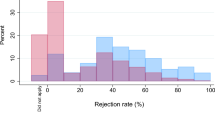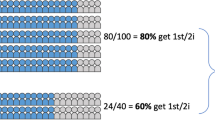Abstract
In the 1990s, most US states adopted new forms of performance-based accountability, e.g., performance-based budgeting, funding, or reporting. This study analyzed changes in institutional performance following the adoption of these new accountability standards. We measured institutional performance by representative education and research indicators—graduation rates and levels of federal research funding. We collected data from 1997 to 2007 and used a hierarchical linear modeling growth curve analysis. The main finding was that states which adopted performance-based accountability did not see a noticeable increase in institutional performance. In addition, we highlighted a critical policy issue—whether state and institutional factors contribute most to institutional performance in higher education.

Similar content being viewed by others
Notes
Resource dependence theory explains why and how higher education responds to the external environment. Neo-institutionalism, on the other hand, explains why and how higher education maintains its value, belief, and culture, and thus explains the stability of higher education. Both these organizational theories provide insights into the impacts of performance-based reforms as well as organizational change from different perspectives.
Brennan and Shah (2000) proposed the impact mechanism to explain the impacts of quality assurance on higher education institutions. The impact mechanism is introduced in this article for discussing the impacts of policy initiatives on institutional performance because the model explains the impacts of reform policy in general.
The excluded 33 institutions are mostly branch campuses though they have institutional identification in NCES database, and did not report data on institutional performance and/or data on the independent variables considered in this study.
Many federal contracts and grants are awarded over a multi-year period. Using multi-year figures would result in apparent instability in funding, because the institution would appear to be awarded the total dollar amount in one year, but nothing in the next years. Since the available data do not specify length of grant period, a more accurate annual measure would be the expenditures of federal grant monies—not the funding itself. Thus, research performance in this study is federally funded research expenditures.
We included only performance funding and budgeting programs, and excluded performance reporting because most of states adopted performance reporting (in Burke and Minassians’ survey, 46 states adopted performance reporting in 2003) and there is not enough variance to compare the program effects between the states with and without the program.
The results were identical when we measured research performance by the number of research publications, an alternative measure of research performance (the results were not reported in this paper).
References
Alexander, F. K. (2000). The changing face of accountability: Monitoring and assessing institutional performance in higher education. Journal of Higher Education, 71(4), 411–431.
Archibald, R. B., & Feldman, D. H. (2008). Graduation rates and accountability: Regressions versus production frontiers. Research in Higher Education, 49, 80–100.
Baird, L. L. (1991). Research productivity in doctoral research departments: Interdisciplinary and intradisciplinary factors. Research in Higher Education, 32, 303–318.
Barnetson, B., & Cutright, M. (2000). Performance indicators as conceptual technologies. Higher Education, 40(3), 277–292.
Birnbaum, R. (2000). The life cycle of academic management fads. Journal of Higher Education, 71(1), 1–16.
Brennan, J., & Shah, T. (2000). Quality assessment and institutional change: Experiences from 14 countries. Higher Education, 40, 331–349.
Bridges, G. L. (1999). Performance-funding of higher education: A critical analysis of performance funding in the State of Colorado. Unpublished doctoral dissertation, University of Colorado.
Brokers, T. D. (1998). A policy analysis of performance-based budgeting in Arkansas higher education. Unpublished doctorate dissertation, University of Arkansas.
Brooks, R. (2005). Measuring university quality. Review of Higher Education, 29(1), 1–21.
Bryk, A. S., & Raudenbush, S. W. (1992). Hierarchical linear models. Newbury Park, CA: Sage.
Burke, J. C., & Minassians, H. (2002). Reporting indicators: What do they indicate? In J. Burke & H. Minassians (Eds.), Reporting higher education results: Missing links in the performance chain. New Directions for Institutional Research, 116, 33–58.
Burke, J. C., & Minassians, H. (2003). Real accountability of accountability lite: Seventh annual survey, 2003. Albany, NY: The Rockefeller Institute of Government.
Carnegie Foundation for the Advancement of Teaching. (1982). The control of the campus: A report on the governance of higher education. California: University of California.
Christal, M. E. (1998). State survey on performance measures: 1996–97. Denver, CO: State Higher Education Executive Officers/Education Commission of the States.
Clark, B. R. (1983). The higher education system: Academic organization in cross-national perspective. Los Angeles: University of California Press.
Csizmadia, T., Enders, J., & Westerheijden, D. F. (2007). Quality management in Hungarian higher education: Organisational responses to governmental policy. Higher Education, 56(4), 439–455.
Dunder, H., & Lewis, D. R. (1998). Determinants of research productivity in higher education. Research in Higher Education, 39(6), 607–631.
Elmore, R. F. (1980). Backward mapping: Implementation research and policy decisions. Political Science Quarterly, 94(4), 601–616.
Fairweather, J. S. (2002). The mythologies of faculty productivity: Implications for institutional policy and decision making. Journal of Higher Education, 73(1), 26–48.
Fox, M. F., & Mohapatra, S. (2007). Social-organizational characteristics of work and publication productivity among academic scientists in doctoral-granting departments. Journal of Higher Education, 78(5), 542–571.
Gander, J. P. (1999). Faculty gender effects on academic research and teaching. Research in Higher Education, 40(2), 171–184.
Gansemer-Topf, A. M., & Schuh, J. H. (2006). Institutional selectivity and institutional expenditures: Examining organizational factors that contribute to retention and graduation. Research in Higher Education, 47(6), 613–642.
Gornitzka, Å. (1999). Governmental politics and organizational change in higher education. Higher Education, 38, 5–31.
Grunig, S. D. (1997). Research, reputation, and resources. Journal of Higher Education, 68(1), 17–52.
Hearn, J. C., & Griswold, C. P. (1994). State-level centralization and policy innovation in US postsecondary education. Educational Evaluation and Policy Analysis, 16(2), 161–190.
Hearn, J. C., Lewis, D. R., Kallsen, L., Holdsworth, J. M., & Jones, L. M. (2006). “Incentives for managed growth”: A case study of incentive-based planning and budgeting in a large public research university. Journal of Higher Education, 77(2), 286–316.
Heller, D. E. (2003). State oversight of academia. In R. G. Ehrenberg (Ed.), Governing academia. Ithaca, NY: Cornell University Press.
Himanen, L., Auranen, O., Puuska, H., & Nieminen, M. (2009). Influence of research funding and science policy on university research performance: A comparison of five countries. Science and Public Policy, 36(6), 419–430.
Hood, C., & Peters, G. (2004). The middle aging of new public management: Into the age of paradox? Journal of Public Administration and Theory, 14(3), 267–282.
Hser, Y. I., Shen, H., Chou, C. P., Messer, S. C., & Anglin, M. D. (2001). Analytic approaches for assessing long-term treatment effects: Examples of empirical applications and findings. Evaluation Review, 25(2), 233–262.
Huisman, J., & Currie, J. (2004). Accountability in higher education: Bridge over troubled water? Higher Education, 48, 529–551.
Jordan, J. M., Meador, M., & Walters, J. K. (1989). Academic research productivity, department size and organization: Further results. Economics of Education Review, 8(4), 345–352.
Layzell, D. T., & Caruthers, J. K. (1995). Performance funding at the state level: Education annual meeting. ASHE annual meeting paper. (ERIC Document Reproduction service no. ED 391 406).
Leslie, D. W., & Berdahl, R. O. (2008). The politics of restructuring higher education in Virginia: A case study. The Review of Higher Education, 31(3), 309–328.
Martinez, M. C., & Nilson, M. (2006). Assessing the connection between higher education policy and performance. Educational Policy, 20(2), 299–322.
McLendon, M. K. (2003). Setting the governmental agenda for state decentralization of higher education. Journal of Higher Education, 74(5), 479–515.
McLendon, M. K., Deaton, R., & Hearn, J. C. (2007). The enactment of reforming in state governance of higher education: Testing the political instability hypothesis. Journal of Higher Education, 78(6), 645–675.
McLendon, M. K., Hearn, J. C., & Deaton, R. (2006). Called to account: Analyzing the origins and spread of state performance-accountability policies for higher education. Educational Evaluation and Policy Analysis, 28(1), 1–24.
National Center for Public Policy and Higher Education. (2006). Measuring up 2006: The state-by-state report card for higher education. Retrieved from http://measuringup2006.highereducation.org.
Neal, J. E. (1995). Overview of policy and practice: Differences and similarities in developing higher education accountability. In G. H. Gaither (Ed.), Assessing performance in an age of accountability: Case studies. New directions for higher education, 91, 5–10.
Oliver, C. (1997). Sustainable competitive advantage: Combining institutional and resource-based views. Strategic Management Journal, 18(9), 697–713.
Perry, R. P., Clifton, R. A., Menec, V. H., Struthers, C. W., & Menges, R. J. (2000). Faculty in transition: A longitudinal analysis of perceived control and type of institution in the research productivity of newly hired faculty. Research in Higher Education, 41(2), 165–194.
Porter, S. R., & Toutkoushian, B. K. (2006). Institutional research productivity and the connection to average student quality and overall reputation. Economics of Education Review, 25, 605–617.
Porter, S. R., & Umbach, P. D. (2001). Analyzing faculty workload data using multilevel modeling. Research in Higher Education, 42(2), 171–196.
Romzek, B. S. (2000). Dynamics of public sector accountability in an era of reform. International Review of Administrative Sciences, 66(1), 21–44.
Rowan, B. (2006). The New institutionalism and the study of educational organizations: Changing ideas for changing times. In H. Meyer & B. Rowan (Eds.), The new institutionalism in education (pp. 15–32). NY: State University of New York Press.
Ruppert, S. S. (1995). Root and realities of state-level performance indicators systems. In G. H. Gaither (Ed.), Assessing performance in an age of accountability: Case studies. New Directions for Higher Education, 91, 11–23.
Ryan, J. F. (2004). The relationship between institutional expenditures and degree attainment at Baccalaureate College. Research in Higher Education, 45, 97–114.
Scott, M., Bailey, T., & Kienzl, G. (2006). Relative success? Determinants of college graduation rates in public and private colleges in the US Research in Higher Education, 47(3), 249–279.
Serban, A. M. (1998). Precursors of performance funding. In J. C. Burke & A. M. Serban (Eds.), Performance funding for public higher education: Fad or trend? New Directions for Higher Education, 91, 11–23.
Shin, J. C. (2009). Building world-class research university: The Brain Korea 21 project. Higher Education, 58(5), 669–688.
Shin, J. C., & Harman, G. (2009). New challenges for higher education: Global and Asia-Pacific perspectives. Asia Pacific Education Review, 10(1), 1–13.
Shin, J., & Milton, S., (2004). The effects of performance budgeting and funding programs on graduation rate in public four-year colleges and universities. Education Policy Analysis Archives, 12(22). Retrieved [2009.7.30] from http://epaa.asu.edu/epaa/v12n22/.
Volkwein, J. F. (1987). State regulation and campus autonomy. In J. C. Smart (Ed.), Higher education handbook of theory and research (Vol. 3). Flemington, NJ: Agathon Press.
Volkwein, J. F., & Malik, S. M. (1997). State regulation and administrative flexibility at public universities. Research in Higher Education, 38, 17–42.
Volkwein, J. F., & Sweitzer, K. V. (2006). Institutional prestige and reputation among research universities and liberal arts colleges. Research in Higher Education, 47(2), 129–148.
Volkwein, J. F., & Tandberg, D. A. (2008). Measuring up: Examining, the connections among state structural characteristics, regulatory practices, and performance. Research in Higher Education, 49, 180–197.
Acknowledgments
I thank anonymous reviews for their helpful comments. Also, I thank Prof. Sande Milton at Florida State University and Prof. Lynn Ilon at Seoul National University for their insightful comments on the draft of this paper.
Author information
Authors and Affiliations
Corresponding author
Rights and permissions
About this article
Cite this article
Shin, J.C. Impacts of performance-based accountability on institutional performance in the U.S.. High Educ 60, 47–68 (2010). https://doi.org/10.1007/s10734-009-9285-y
Published:
Issue Date:
DOI: https://doi.org/10.1007/s10734-009-9285-y




